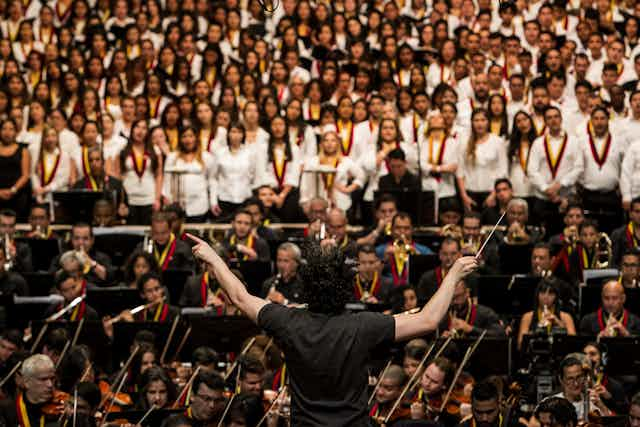Venezuela’s El Sistema (“the system”) is probably the world’s most famous music education programme – and its most misunderstood.
El Sistema is a vast operation that brings hundreds of thousands of Venezuelan children, many of them ostensibly poor, under the umbrella of a classical orchestral training scheme in the name of their “salvation”. It has been covered extensively in the past decade, often by journalists who are given red-carpet tours and press office accounts and the success stories of individual musicians. This has all given the programme an unduly rosy international image, further distorted by a romanticised vision of the power of music.
However, recent studies by academics and researchers – myself included – paint a rather different picture. They point to a high dropout rate and low poverty rate among the musicians, limited evidence of social transformation, and various other systemic problems. But with journalists and others around the world now in thrall to El Sistema’s miraculous story, these inconvenient accounts are largely overlooked.
Instead, the Anglophone media in particular tends to stick to an idealised image of El Sistema that it began constructing around the time of the Simón Bolívar Youth Orchestra’s rapturously received performance at the 2007 BBC Proms in London. The programme began to be hailed globally as a “miracle”, a glorious project that transforms the lives of Venezuela’s poorest children through classical music.
And now, as the domestic political tensions around El Sistema dramatically increase, the same dynamic is playing out again.
Looking away
As Venezuela’s political crisis has deepened and its economy all but collapsed, dissatisfaction with the state-funded music program has surged. Many Venezuelans particularly resent its iconic figurehead, the conductor Gustavo Dudamel, whose high public profile, warm relations with top government figures and long-term silence over the escalating civil strife have alienated many of his compatriots.
This is a significant narrative kink in one of classical music’s biggest stories – and yet it was barely covered by the usually attentive media. When a government minister was captured on camera telling El Sistema’s employees to toe the party line or find a new job, there was a furore online, but mainstream journalists looked away.
But then, two developments finally caught their attention.
First, Sistema musician Armando Cañizales was killed in an anti-government protest on May 3 2017. Dudamel responded with a statement on Facebook criticising the government. Then a Sistema violinist, Wuilly Arteaga, became a fixture in the anti-government marches, playing his violin in front of lines of riot police.

Perhaps unsurprisingly, these developments were picked up by major outlets including the New York Times, which headlined a major feature story with the words Venezuela Musicians Rise Up.
In a few strokes, the coverage shifted from blithe neglect to breathless over-dramatisation. Media reports around the world cast Dudamel as a heroic resistance figure issuing a “fiery statement” and “denouncing” the government, failing to take account of his long history of silence and many Venezuelans’ deep scepticism about him. That scepticism seems to have been little moved by the Facebook post, which many – including members of Cañizales’s family – saw as too little, too late.
Dudamel has since returned to his habitual silence, interspersed with the occasional platitude about peace and unity, undermining the notion that he was leading an uprising as opposed to simply managing his image. Arteaga, meanwhile, has now left Venezuela for the US, where he is enjoying his 15 minutes of fame on the Latino chat-show circuit.
Business as usual
After Cañizales’s death, around 50 musicians staged a protest outside the Sistema headquarters. The largest banner declared that “El Sistema cannot sound the same”. Yet with 827,000 musicians currently enrolled in El Sistema, according to official figures, a tiny one-off protest hardly amounts to a musicians’ uprising. What’s genuinely striking is that nearly two months after the protest, El Sistema in fact does sound the same.
It pays to think about what hasn’t happened. There has been no organised orchestral protest, no mass resignations, no refusal to go on the international tours that the government funds for propaganda purposes. No leading conductor or soloist has publicly resigned over the increasing use of Sistema orchestras for political ends. Dudamel’s schedule continues to show overseas engagements with El Sistema’s top orchestras.

The isolated actions of a few individuals do not suggest that El Sistema is, as one writer recently called it, “the Venezuelan government’s newest opponent”. With its near-monopoly on classical music in Venezuela, the program still exerts significant control over its musicians – and it remains firmly aligned with the regime. Some rank-and-file members might join the protesters, but its leaders march for the government.
Cañizales died in an anti-government protest, but that doesn’t mean he is representative of hundreds of thousands of his fellow musicians. Indeed, Wuilly Arteaga, the now-famous violinist of the protests, left El Sistema before he emerged as an iconic musical hero; he has criticised his former colleagues for their political complicity and hypocrisy.
The recent attempts to paint Dudamel and El Sistema as heroes of the resistance are simply the latest in a long line of romanticised misrepresentations. A more representative figure would be the first Sistema musician to become a cause célèbre in this year’s protests, horn-player Frederick Chirino Pinto – who made it clear he was not in fact joining in, but simply on his way to a rehearsal.

